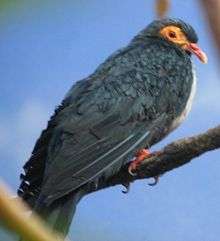Mountain pigeon
Gymnophaps is a genus of bird in the pigeon family Columbidae; it includes four species, all called mountain pigeons. Mountain pigeons live in the forested hills and mountains of certain islands in eastern Indonesia and in the region of Melanesia. They are tree-dwellers and eat fruit. A remarkable aspect of these pigeons is that they have bright red skin around the eyes. Otherwise, they are dark gray on the back and wings, with paler heads and undersides. Males and females look mostly alike, though the female Papuan mountain pigeon has a grayer belly than the male. Mountain pigeons move around a lot and are often seen flying, usually in flocks of at least ten or as many as a hundred or more birds. They are not known to do a lot of loud cooing, rather their vocalizations are muted or wheezy when they make any noise at all.
| Mountain pigeon | |
|---|---|
 | |
| Papuan mountain pigeon | |
| Scientific classification | |
| Kingdom: | Animalia |
| Phylum: | Chordata |
| Class: | Aves |
| Order: | Columbiformes |
| Family: | Columbidae |
| Subfamily: | Ptilinopinae |
| Genus: | Gymnophaps Salvadori, 1874 |
| Type species | |
| Gymnophaps albertisii Salvadori, 1874 | |
The ranges of the four species do not overlap, so this genus is an example of probable allopatric speciation. Two species are island endemics: the Buru mountain pigeon is endemic to the Maluku Islands, and the pale mountain pigeon is endemic to the Solomon Islands. The Papuan mountain pigeon has a range in between the others; it lives on the island of New Guinea and on nearby smaller islands.
Taxonomy
The genus Gymnophaps was introduced by the Italian zoologist Tommaso Salvadori in 1874 to accommodate the Papuan mountain pigeon (Gymnophaps albertisii).[1][2] The name combines the Ancient Greek gumnos meaning "bare" or "naked" with phaps meaning "pigeon"[3]
The genus contains four species:[4]
- Papuan mountain pigeon, Gymnophaps albertisii
- Buru mountain pigeon, Gymnophaps mada
- Seram mountain pigeon, Gymnophaps stalkeri
- Pale mountain pigeon, Gymnophaps solomonensis
References
- Salvadori, Tommaso (1874). "Altre nuove specie di uccelli della Nuova Guinea e di Goram raccolte dal Signor L.M. D'Albertis". Annali del Museo Civico di Storia Naturale di Genova (in Italian and Latin). 6: 81–88 [86].
- Peters, James Lee, ed. (1937). Check-List of Birds of the World. Volume 3. Cambridge, Massachusetts: Harvard University Press. p. 56.
- Jobling, James A. (2010). The Helm Dictionary of Scientific Bird Names. London: Christopher Helm. p. 182. ISBN 978-1-4081-2501-4.
- Gill, Frank; Donsker, David; Rasmussen, Pamela, eds. (2020). "Pigeons". IOC World Bird List Version 10.1. International Ornithologists' Union. Retrieved 17 March 2020.
- Gibbs, David; Barnes, Eustace; Cox, John (2001). Pigeons and Doves: A Guide to the Pigeons and Doves of the World. Yale University Press. pp. 168–169, 577–580. ISBN 0-300-07886-2.